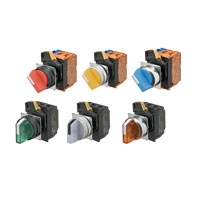6 A 240 VAC, 10 A 120 VAC
A22NS / A22NW
Selector Switches

22-mm dia. Knob-type Selector Switches. Control panel miniaturization through a more compact design and modified wiring direction. Addition of Push-In Plus terminal blocks for easy wiring.
about this Product Family
- Features
- Lineup
- Specifications
- Dimensions
- Accessory
- Catalog
last update: October 03, 2016
Certified Safety Standard Ratings
UL 508 (File No. E76675), CSA C22.2 No.14
TÜV (EN60947-5-1)
AC-15 3 A 240 VAC
DC-13 4 A 24 VDC
CCC (GB14048.5)
AC-15 3 A 240 VAC
DC-13 4 A 24 VDC
Application Standards
UL1059 and UL486E (Push-In Plus terminal block type)
Ratings
Contacts (Standard Load)
| Rated insulation voltage | 600 V | |||||
|---|---|---|---|---|---|---|
| Rated carry current | 10 A | |||||
| Rated voltage | 24 V | 120 V | 240 V | 380 V | 440 V | |
| AC at 50/60 Hz | Resistive load (AC-12) | 10 A | 10 A | 6 A | 2 A | 2 A |
| Inductive load (AC-15) | 10 A | 6 A | 3 A | 1.9 A | 1.6 A | |
| DC | Resistive load (DC-12) | 8 A | 2.2 A | 1.1 A | --- | --- |
| Inductive load (DC-13) | 4 A | 1.1 A | 0.55 A | --- | --- | |
Note: 1. The above ratings were obtained by conducting tests under the following conditions.
(1) Ambient temperature: 20 ±2°C
(2) Ambient humidity: 65% ±5% RH
(3) Operating frequency: 30 operations/minute
2. Minimum applicable load: 10 mA at 5 VDC.
(1) Ambient temperature: 20 ±2°C
(2) Ambient humidity: 65% ±5% RH
(3) Operating frequency: 30 operations/minute
2. Minimum applicable load: 10 mA at 5 VDC.
LED Lamps
| Rated voltage | Applied voltage | Rated current |
|---|---|---|
| 6 VAC/DC | 6 VAC/DC ±10% | Approx. 11 mA (red, orange, yellow, or blue)
Approx. 5 mA (white or green) |
| 12 VAC/DC | 12 VAC/DC ±10% | Approx. 12 mA (red, orange, yellow, or blue)
Approx. 5 mA (white or green) |
| 24 VAC/DC | 24 VAC/DC ±10% | Approx. 12 mA (red, orange, yellow, or blue)
Approx. 5 mA (white or green) |
| 100 VAC | 100 VAC ±10% | Approx. 12 mA (red, orange, yellow, or blue)
Approx. 5 mA (white or green) |
| 110 VAC | 110 VAC ±10% | |
| 120 VAC | 100 to 130 VAC | |
| 200 VAC | 200 VAC ±10% | Approx. 12 mA (red, orange, yellow, or blue)
Approx. 5 mA (white or green) |
| 220 VAC | 220 VAC ±10% | |
| 230 VAC | 230 VAC ±10% | |
| 240 VAC | 220 to 250 VAC |
Characteristics
| Type | Selector Switches | ||
|---|---|---|---|
| Item | Non-lighted models | Lighted models | |
| Allowable
operating frequency |
Mechanical | 30 operations/minute max. | |
| Electrical | 30 operations/minute max. | ||
| Insulation resistance | 100 MΩ min. (at 500 VDC) | Not available for lighting units | |
| Contact resistance | 100 mΩ max. (initial value) | ||
| Dielectric
strength |
Between terminals of
same polarity |
2,500 VAC at 50/60 Hz for 1 min.
(initial value) |
Not available for lighting units |
| Between each terminal
and ground |
2,500 VAC at 50/60 Hz for 1 min. (initial value) | ||
| Vibration
resistance |
Malfunction | 10 to 55 Hz, 1.5-mm double amplitude (malfunction within 1 ms) | |
| Shock
resistance |
Malfunction | 1,000 m/s2 max. (malfunction within 1 ms) | |
| Durability | Mechanical | 500,000 operations min. (Switches with 3 positions: 300,000 operations min.) | |
| Electrical | 500,000 operations min. (Switches with 3 positions: 300,000 operations min.)
(250 VAC, 3 A, with an inductive load having power factor cos θ = 0.4) |
||
| Ambient operating temperature *1 | -25 to 70°C | -25 to 55°C | |
| Ambient operating humidity | 35% to 85% RH | ||
| Ambient storage temperature *1 | -40 to 80°C | ||
| Degree of protection *2 | Conforming to IP66, NEMA 4X, NEMA 13 | ||
| Electric shock protection class | Class II | ||
| PTI (tracking characteristic) | 175 | ||
| Degree of contamination (application
environment) |
3 (EN 60947-5-1) | ||
| Weight | Approx. 50 g (for 1NC/1NO) | Approx. 60 g (for 1NC/1NO) | |
*1. With no icing or condensation.
*2. Degree of protection from the front of the panel.
Operating Characteristics (for SPST-NO/SPST-NC)
| Type | Selector Switches | |
|---|---|---|
| Item | Manual reset | Automatic reset |
| Total travel force (torque) (maximum TTF) | 0.6 Nm | 0.6 Nm |
| Total travel (TT) | 2 positions: Approx. 90°, 3 positions: Approx. 45° | |
| Resetting force (torque) (RF) | 0.5 N·m max. | --- |
Examples of Linked Contact Blocks (Screw terminal block type)

| Selector Switches | ||||
|---|---|---|---|---|
| 2 positions | 3 positions | |||
| Lighted | Non-lighted | Lighted | Non-lighted | |
| Linking example |  |

* |
 |
 |
* If you use three Contact Blocks in stage 1, you can add one more Contact Block in the middle of stage 2.
Note: If you increase the number of Contact Blocks, evaluate the Switch under actual working conditions before
permanent installation and use the Switch within a number of switching operations that will not adversely affect the
Switch's performance.
Note: If you increase the number of Contact Blocks, evaluate the Switch under actual working conditions before
permanent installation and use the Switch within a number of switching operations that will not adversely affect the
Switch's performance.
last update: October 03, 2016


